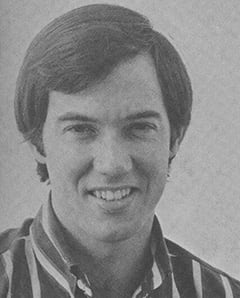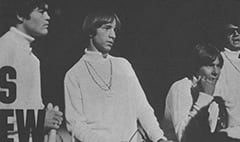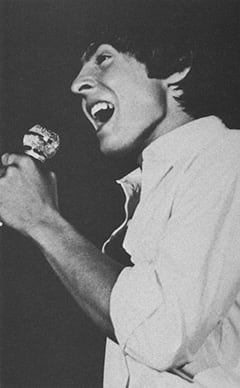
Chip Douglas, at just 25, is one of today’s brightest producers and has produced both the Monkees’ albums, Headquarters and Pisces, Aquarius Capricorn and Jones, Ltd.
Chip was born in San Francisco, California and moved to Hawaii with his family when he was three years old. His father was a doctor on a sugar plantation on the north shore of Oahu.
When Chip was older he came to Los Angeles and joined the MFQ. He later played bass for the Turtles and last year was asked by the Monkees to do their record producing. Many hours went into their latest and greatest album on Colgems; and Chip recounts the interesting details below.
How long did you and the Monkees work on the new album?
Well, really it’s been on and off since we finished the last one.
Were there any big plans made before you started actual work on it?
No, there’s never any chance to plan exactly what you want to do, you just do what has to be done. Recording comes third on the list as far as the Monkees go. First it’s shooting the TV show, then touring, and finally we squeeze in a little recording time.
Was it hard recording the album in different cities?
It took a while to get used to each studio, maybe a couple of hours more than usual. For the most part they were on tour and doing a lot of singing, so the vocals came off pretty good. We only recorded vocals on the road and they came out a lot better because the boys were doing a lot of singing and their voices were used to it, so they could hit a lot higher notes.

Why did you decide to leave in the talking before the songs start?
We probably shouldn’t have left it in on “Daydream Believer.” The disc jockeys don’t like the talking at the beginning, because it’s hard to cue up. I just mixed everything down for an album. I wasn’t thinking about singles. Then, they decided to put “Daydream Believer” out as a single. I completely forgot about the talking intro on that, but it’s just as well anyway.
We try to leave as much of the talking bits on as possible, because it’s a little something extra for the listener. I think the Monkees should do a lot more of that sort of thing. I think it would be groovy if they have about six numbers where they weren’t even singing—just talking and doing bits. Hank, our engineer and I went over some of the left over tapes the other day and there’s a lot of funny stuff left. They’ll probably go on the next album for sure.
How did you come to use a Moog synthesizer on the album?
Micky found it. He heard of it somehow and he went over to some guy’s house who had one. Micky has been interested in electronic music from some time. The guy who had the Moog did the score for “Forbidden Planet” some years ago and he was showing it to Micky. The Moog synthesizer is an electronic thing which duplicates any kind of sound. So Micky bought one. He played it on one tune, and we all dug it. Then we thought it would be kinda neat to have a jazz solo on this other tune, so we got Paul Beaver, the guy who built it, to come down and play it. He does some work around Los Angeles with his Moog, like he did the news breaks for KHJ radio and the sounds at the end of Screen Gems’ films are done with the Moog synthesizer. It’s just breaking into pop music.
Did the Monkees have fun experimenting with it?
Micky was having a ball on this tune “Dayly [sic], Nightly” so we let him go four times on it, and just kept overdubbing stuff all over the place. Then later we sorted it out on the tape and I just brought up the best parts on the final track.

Who chose the name for the album?
I don’t remember who it was exactly. It seems that one of the Monkees was on the phone and Lester Sill, who publishes their music, and I were discussing what we were going to call the album. Someone had thought of the idea “Monkees 4 U.” But then one of the Monkees came up with “Pisces, Aquarius, Capricorn and Capricorn, Ltd.” For some reason, I don’t know how it started, the name just popped up from nowhere in the office and someone said, “How about Pisces, Aquarius, Capricorn and Jones, Ltd.”? I laughed, and I thought, “That’s great!” All the Monkees thought it sounded groovy, so that what they called it.
Can you recall any funny incidents while recording this album?
There was the time that Ann Moses and her friend came in and clapped on “Daydream Believer” and that was pretty funny, because we had to do it several times because you have to clap a special way.
We had many, many hilarious hours riding to and from the studio in New York. The scene with the girls following the limousines was incredible. They’d follow us all the way into downtown New York.
Once a little girl got in the limousine with Davy and she didn’t even know what to do. She just sort of jumped in and there she was face to face with David Jones for the first time! And Davy had one of those shocked looks on his face. She didn’t know what to do, so finally she grabbed him and locked her arms around him and wouldn’t let go. Finally we let her out a little ways away from the crowds. I’ll never forget that!
Also, there’s a whole bit that’s not on the album that Micky did ad lib. Micky does this whole comedy thing where he starts talking about the Walls of Jericho and he does a whole thing on that. I’ve got it on tape and we edited it and put it together and it’s really funny. Then Davy’s trying to play a French horn in the background and it’s very funny.

How did you come to include pieces like Peter’s tongue-twister, which aren’t really songs at all?
Peter has a bunch of those things he does every once in a while. One is called “Alvin,” that his brother wrote. “Alvin” didn’t get on this album, but it’s very funny. Peter did that “Peter’s [sic] Percival…” thing for me one day and I cracked up and I thought, “How great, we’ll stick it on the album!” I wish we could have more of them, but we didn’t have the time.
How did you get Mike’s voice to sound so different on “Don’t Call On Me”?
That’s just another side of Mike Nesmith. He just sings that way. He had been saying for some time, “You ought to let me sing a ballad.” And everybody would say, “Okay, great.” So finally he came up with this ballad and everyone said, “Hey, great song, let’s do it!” So we cut the track on it.
Did you use a special effect to make his voice sound different?
No! It’s just him, one take, no doubling, no nothing. He’s just singing really soft and close to the microphone.
Whose voice is the most difficult to record?
Mike’s is the hardest to record when he sings out. It’s a lot better since he’s had his tonsils out. His voice is very hard to get crisp. It sounds kind of fuzzy all the time, but that’s the way it is. Only when he gets into a certain register does it start popping through and he has to really sing hard and intense in order to get the words across. So his, sound-wise, is the hardest.
Some people still question the Monkees’ ability to play their own instruments. Did they play on this album?
Sure. Sometimes we may use strings and things like that, and they can’t do those things. But the basic tracks they do themselves. There’s at least a couple of them there on the tracks all the time. Maybe not all four of them exactly, only on every little thing, but they do their own backing tracks.

Why do you record mostly at night?
Well, first of all, they work during the day. Also their voices get warmed up at night. They don’t really like to record during the day. Micky doesn’t. He doesn’t like to come in before six in the evening and then he likes to work until about two a.m. Everyone is different. I like to record during the day. I believe you can get the most done because you’re freshest in the early part of the day, as far as tracks go, and then get into vocals in the evening time.
How much time would you say goes into one album track from start to finish?
I’d say maybe 18 or 20 hours for each tune. It can be as much as 24 or 25 hours. Sometimes it’s four hours, but usually because we can’t record every day when we come in we have to start from scratch. We have to go through all the sounds on the instruments, get the arrangement down and things like that. The Monkees don’t like to practice outside the studio. They like to rehearse right in the studio.
Do you see the boys much outside the recording studio?
Sure, as much as possible. I go over to their houses and talk about the songs first and then it’s always a good idea to plan out what we want to do. We’re doing that more and more now—getting together and talking about the songs. It works out a lot better.
Have your impressions of the Monkees changed after working with them for over a year now?
No. I hold the same high opinion of each of them that I always have.

Who are some of the other artists you are working with?
I’m producing a group called the Dillards, whose single should be out around the first of the year. Their sounds are like an updated bluegrass-rock; and I think the record we’re working on now is gong to be a gigantic success.
I’m also working with a group whose name isn’t quite set yet because they may be adding another member. John Stewart and Buffey Ford is what they call themselves at the moment. John wrote “Daydream Believer.”
You have redone several of the Monkees early tunes, do you think you’ll re-record “Valerie”? [sic]
It’s quite possible.
There was talk of putting out a Monkee album recorded live at one of their concerts. Do you see this in the near future?
We recorded them live at three of their concerts with the act they did for the summer tour. Some things came out good and some things didn’t come out so good. Mainly the big appeal in a live album is in-between the numbers all the clowning around. The excitement with all the kids screaming is groovy, but it’s not that great sound-wise. Live rock and roll things are very difficult to record, but it’s really groovy. There’s no immediate plans and no release dates, but we will quite possibly put some of it on the next album.


